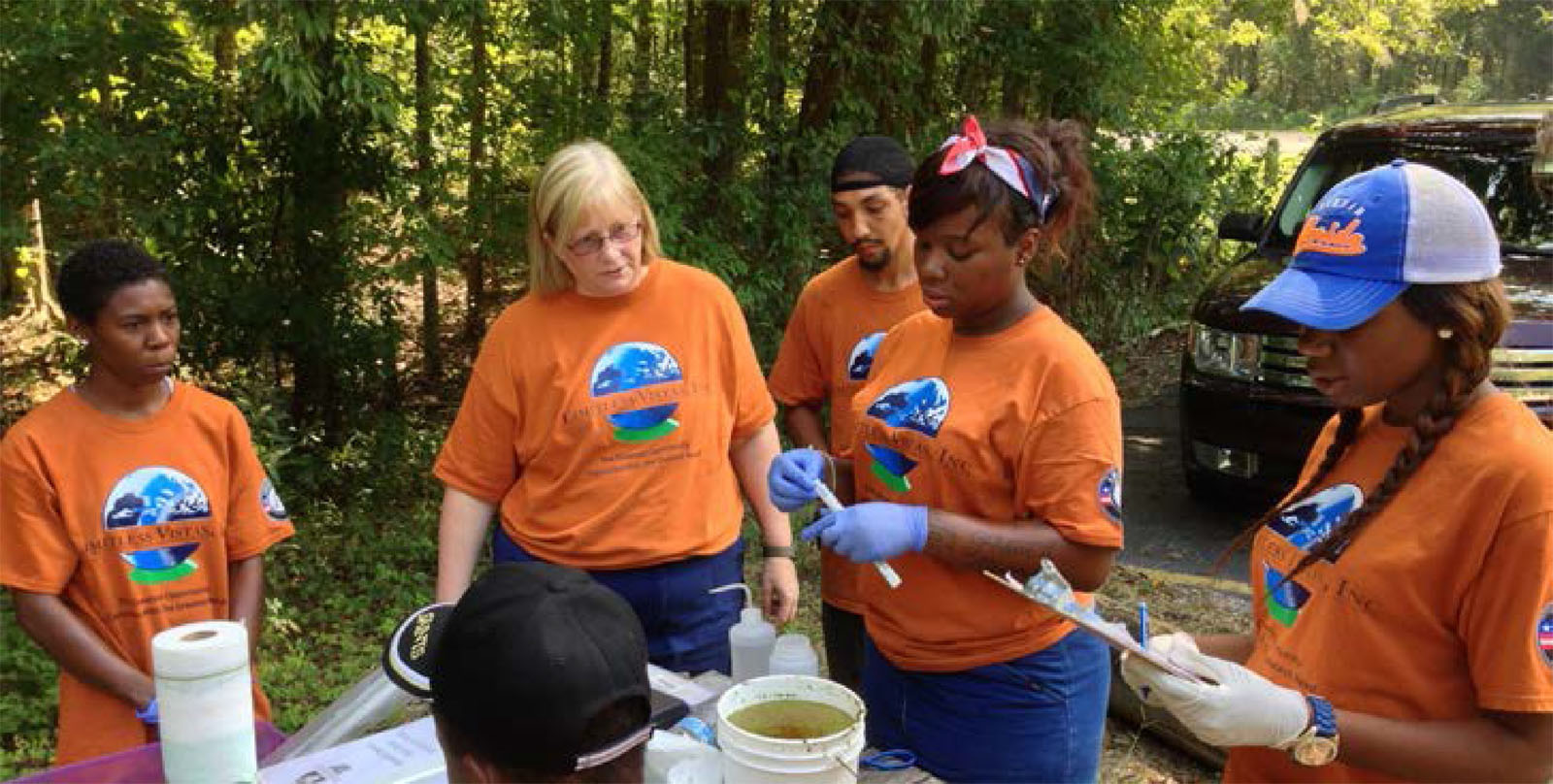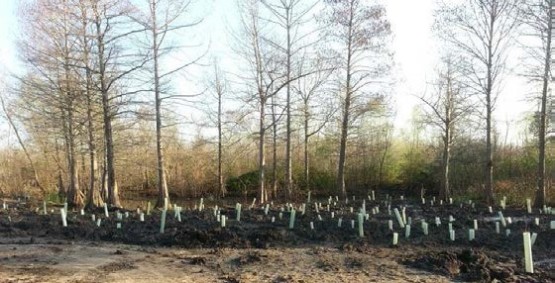Coastal Restoration and Community Engagement
 Coastal Restoration and Community Engagement -‐ BFA through the non-‐profit Limitless Vistas, Inc. that Patrick A. Barnes and BFA established in 2006 our staff has worked extensively on the issues of coastal restoration and vulnerable community engagement.
Coastal Restoration and Community Engagement -‐ BFA through the non-‐profit Limitless Vistas, Inc. that Patrick A. Barnes and BFA established in 2006 our staff has worked extensively on the issues of coastal restoration and vulnerable community engagement.
Wetland Restoration Training Program – In late 2013, early 2014 Limitless Vistas, Inc. developed a Wetland Restoration Training Program to enable racially diverse, socially and economically disadvantaged youth to participate in the growing wetland restoration industry in the Gulf Coast Region. This program enhances LVI’s already established Environmental Technician Program that is dedicated to helping at-‐risk young adults receive the training needed to work as entry-‐level technicians in the environmental industry. The Wetland Restoration Training Program includes training and hands-‐on projects in coastal ecosystems, native and invasive species, the impact of water quality on wetland systems, introduction to safety in nature, and targeted wetland restoration projects. This program introduces urban youth to nearby wetland and coastal ecosystems through community service learning projects that are supported by local federal agencies and local non-‐profit wetland protection and restoration organizations. Community service learning projects performed in the past three years have included partners such as Jean Lafitte National Historical Park and Preserve – Barataria Unit (Jean Lafitte – Barataria Preserve), Louisiana Universities Marine Consortium (LUMCON), Barataria-‐Terrebonne National Estuary Program (BTNEP), Coalition to Restore Coastal Louisiana (CRCL), and Audubon Nature Center.
Audubon Nature Center Wetland Restoration Project – Audubon Nature Center is located in New Orleans East, an area hard hit by past hurricanes, and is still in recovery mode from the hit sustained in 2005 by Hurricane Katrina. Through this conservation project, LVI members are helping to eradicate invasive species, plant native trees, maintain trails, and act as team leaders for other volunteer organizations. Since January 2014 LVI members have helped clear the 80 acre park of invasive Chinese Tallow trees, helped to plant 500 Bald Cypress and Oak trees, helped maintain a 1-‐mile nature trail, and have acted as team leaders for over 300 volunteers ranging in age from 16-‐65 years old. Prior to this project, the members had no substantial knowledge about the importance of wetlands, the flora and fauna found in Louisiana wetlands, and the process by which wetlands are restored after being damaged by hurricanes. Members were trained by Audubon to be Team Leaders for volunteers brought in to kill Chinese Tallow trees through girdling. None of the members had ever been given the opportunity to develop their leadership skills to the degree needed for this project, but all of them have exceeded expectations.
Barataria Terrebonne National Estuary Program Water Quality Project – BTNEP is a partnership of government, business, scientists, conservation organizations, agricultural interests, and individuals for the preservation, protection, and restoration of the Barataria-‐Terrebonne National Estuary in southeast Louisiana. LVI has been a participant in BTNEP’s H2O Water Quality Workshop for teachers, which enables LVI to train participants in water quality testing, learn about estuaries and watersheds while conducting scientific data collection, and learn stewardship through awareness that local environments function as part of larger, connected ecosystems. LVI has developed a water quality testing project that includes three different types of settings to enable participants to observe differences between the sites. LVI participants collect water samples from the Jean Lafitte-‐Barataria Preserve, Crown Point boat launch and at the Audubon Nature Center. These samples are tested on-‐site and the results are recorded for entry into three different databases. Through this program students are taught how to identify invasive aquatic and land-‐based flora and fauna, mapping techniques, scientific field-‐testing and note taking, and database entry.
Jean Lafitte National Historical Park and Preserve Tree Planting Project – Through the Coalition to Restore Coastal Louisiana (CRCL), five LVI participants helped plant over 500 native trees in the Jean Lafitte -‐ Barataria Preserve. Also in partnership with CRCL our urban youth traveled to Grand Isle and Raccoon island to install sand fences and measure sand accretion rates collect water samples from existing restoration projects. Through these projects participants learned about boater safety, coastal ecosystems, invasive species, native trees, the importance of natural resources in hurricane protection, and how to scientifically document your findings in the field. This was also unique because it provided the opportunity to experience a boat rides into the swamps of Southeast Louisiana – a place so near, yet inaccessible to them without participation in LVI programs.
New Orleans City Park Beautification Projects – LVI participates have participated in several beautification projects which incorporate stormwater management and use of native plants at New Orleans City Parks over the past three years. The first project was the installation of Song Bird Habitats that promoted bird watching within the parks. A more recent project included installation of native landscaping within the five-‐acre Sydney and Walda Besthoff Sculpture Garden. These projects enabled LVI participants to earn hands-‐on landscaping experience; as well as, learn more about environmental sustainability, ecosystem services, gardening, civic pride, and art.
 Coastal Restoration and Community Engagement -‐ BFA through the non-‐profit Limitless Vistas, Inc. that Patrick A. Barnes and BFA established in 2006 our staff has worked extensively on the issues of coastal restoration and vulnerable community engagement.
Coastal Restoration and Community Engagement -‐ BFA through the non-‐profit Limitless Vistas, Inc. that Patrick A. Barnes and BFA established in 2006 our staff has worked extensively on the issues of coastal restoration and vulnerable community engagement.
Wetland Restoration Training Program – In late 2013, early 2014 Limitless Vistas, Inc. developed a Wetland Restoration Training Program to enable racially diverse, socially and economically disadvantaged youth to participate in the growing wetland restoration industry in the Gulf Coast Region. This program enhances LVI’s already established Environmental Technician Program that is dedicated to helping at-‐risk young adults receive the training needed to work as entry-‐level technicians in the environmental industry. The Wetland Restoration Training Program includes training and hands-‐on projects in coastal ecosystems, native and invasive species, the impact of water quality on wetland systems, introduction to safety in nature, and targeted wetland restoration projects. This program introduces urban youth to nearby wetland and coastal ecosystems through community service learning projects that are supported by local federal agencies and local non-‐profit wetland protection and restoration organizations. Community service learning projects performed in the past three years have included partners such as Jean Lafitte National Historical Park and Preserve – Barataria Unit (Jean Lafitte – Barataria Preserve), Louisiana Universities Marine Consortium (LUMCON), Barataria-‐Terrebonne National Estuary Program (BTNEP), Coalition to Restore Coastal Louisiana (CRCL), and Audubon Nature Center.
Audubon Nature Center Wetland Restoration Project – Audubon Nature Center is located in New Orleans East, an area hard hit by past hurricanes, and is still in recovery mode from the hit sustained in 2005 by Hurricane Katrina. Through this conservation project, LVI members are helping to eradicate invasive species, plant native trees, maintain trails, and act as team leaders for other volunteer organizations. Since January 2014 LVI members have helped clear the 80 acre park of invasive Chinese Tallow trees, helped to plant 500 Bald Cypress and Oak trees, helped maintain a 1-‐mile nature trail, and have acted as team leaders for over 300 volunteers ranging in age from 16-‐65 years old. Prior to this project, the members had no substantial knowledge about the importance of wetlands, the flora and fauna found in Louisiana wetlands, and the process by which wetlands are restored after being damaged by hurricanes. Members were trained by Audubon to be Team Leaders for volunteers brought in to kill Chinese Tallow trees through girdling. None of the members had ever been given the opportunity to develop their leadership skills to the degree needed for this project, but all of them have exceeded expectations.
Barataria Terrebonne National Estuary Program Water Quality Project – BTNEP is a partnership of government, business, scientists, conservation organizations, agricultural interests, and individuals for the preservation, protection, and restoration of the Barataria-‐Terrebonne National Estuary in southeast Louisiana. LVI has been a participant in BTNEP’s H2O Water Quality Workshop for teachers, which enables LVI to train participants in water quality testing, learn about estuaries and watersheds while conducting scientific data collection, and learn stewardship through awareness that local environments function as part of larger, connected ecosystems. LVI has developed a water quality testing project that includes three different types of settings to enable participants to observe differences between the sites. LVI participants collect water samples from the Jean Lafitte-‐Barataria Preserve, Crown Point boat launch and at the Audubon Nature Center. These samples are tested on-‐site and the results are recorded for entry into three different databases. Through this program students are taught how to identify invasive aquatic and land-‐based flora and fauna, mapping techniques, scientific field-‐testing and note taking, and database entry.
Jean Lafitte National Historical Park and Preserve Tree Planting Project – Through the Coalition to Restore Coastal Louisiana (CRCL), five LVI participants helped plant over 500 native trees in the Jean Lafitte -‐ Barataria Preserve. Also in partnership with CRCL our urban youth traveled to Grand Isle and Raccoon island to install sand fences and measure sand accretion rates collect water samples from existing restoration projects. Through these projects participants learned about boater safety, coastal ecosystems, invasive species, native trees, the importance of natural resources in hurricane protection, and how to scientifically document your findings in the field. This was also unique because it provided the opportunity to experience a boat rides into the swamps of Southeast Louisiana – a place so near, yet inaccessible to them without participation in LVI programs.
New Orleans City Park Beautification Projects – LVI participates have participated in several beautification projects which incorporate stormwater management and use of native plants at New Orleans City Parks over the past three years. The first project was the installation of Song Bird Habitats that promoted bird watching within the parks. A more recent project included installation of native landscaping within the five-‐acre Sydney and Walda Besthoff Sculpture Garden. These projects enabled LVI participants to earn hands-‐on landscaping experience; as well as, learn more about environmental sustainability, ecosystem services, gardening, civic pride, and art.


